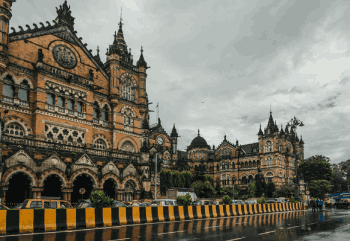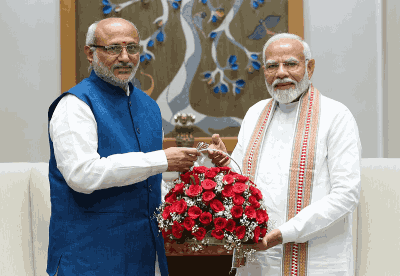District Overview and Electoral Landscape
West Champaran district represents a crucial political battleground in Bihar, comprising 9 assembly constituencies spread across two Lok Sabha seats: Valmiki Nagar and Paschim Champaran. With 2.58 million registered voters as of 2024, the district has emerged as an NDA stronghold, winning 8 out of 9 seats in the 2020 assembly elections.
The district’s strategic importance stems from its border location with Nepal, significant Tharu tribal population, and role as a traditional migration source for employment-seeking populations across India.
Lok Sabha Constituency-wise Breakdown
Valmiki Nagar Lok Sabha Constituency (6 Assembly Seats)
Assembly Constituencies:
- Valmiki Nagar (General) – JD(U)
- Ramnagar (SC Reserved) – BJP
- Narkatiaganj (General) – BJP
- Bagaha (SC Reserved) – BJP
- Lauriya (General) – BJP
- Sikta (General) – CPI(ML)L
2024 Lok Sabha Result: Sunil Kumar (JD-U) won with 523,422 votes (47.5%), defeating RJD’s Deepak Yadav by 98,675 votes.
Paschim Champaran Lok Sabha Constituency (3 Assembly Seats in West Champaran)
Assembly Constituencies:
7. Nautan (General) – BJP
8. Chanpatia (General) – BJP
9. Bettiah (General) – BJP
2024 Lok Sabha Result: Sanjay Jaiswal (BJP) won with 580,421 votes (53.4%), defeating Congress’s Madan Mohan Tiwari by 136,568 votes[attached file].
2020 Assembly Election Results Analysis
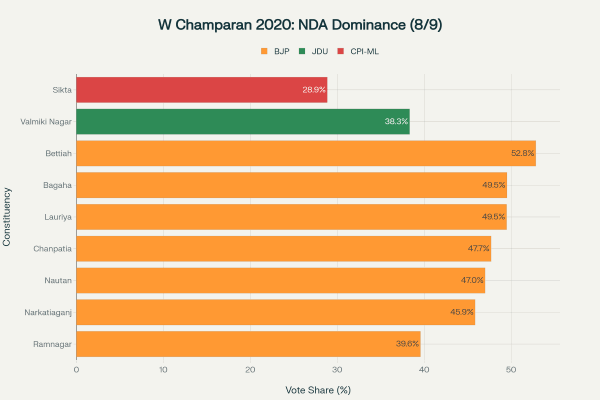
2020 West Champaran results showing BJP’s dominance with 6 seats, JDU with 2, and CPI-ML with 1
NDA’s Dominant Performance
The National Democratic Alliance achieved an overwhelming victory in West Champaran, securing 8 out of 9 seats with an impressive 88.9% success rate:
BJP Performance (6 seats):
- Bettiah: Renu Devi – 52.83% vote share
- Bagaha: Ram Singh – 49.51% vote share
- Lauriya: Vinay Bihari – 49.48% vote share
- Chanpatia: Umakant Singh – 47.69% vote share
- Nautan: Narayan Prasad – 47.0% vote share
- Narkatiaganj: Rashmi Varma – 45.85% vote share
- Ramnagar: Bhagirathi Devi – 39.57% vote share
JD(U) Performance (1 seat):
- Valmiki Nagar: Dhirendra Pratap Singh – 38.32% vote share
Opposition Performance:
- Sikta: Birendra Prasad Gupta (CPI-ML) – 28.85% vote share (only non-NDA victory)
Key Victory Margins
Several constituencies demonstrated decisive NDA victories:
- Ramnagar: 35,688 vote margin (largest in district)
- Lauriya: 32,448 vote margin
- Bagaha: 30,020 vote margin
- Nautan: 25,894 vote margin
Only Sikta showed competitive dynamics with CPI(ML)L winning by a narrow 2,302 vote margin, highlighting the constituency’s unique left-leaning political culture.
Demographic Analysis and Voting Patterns
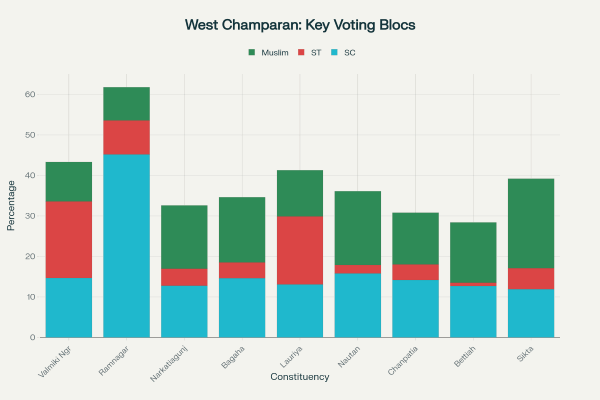
Demographic breakdown showing varied caste and religious composition across West Champaran constituencies
Caste Composition Impact
Scheduled Castes (11.9% – 45.2%):
- Ramnagar leads with 45.2% SC population, explaining BJP’s strong performance in this reserved seat
- Average SC population: 17.1% across all constituencies
- Political Impact: Strong BJP consolidation among SC voters, particularly Paswans and Chamars
Scheduled Tribes (0.8% – 18.9%):
- Valmiki Nagar has the highest ST population at 18.9%, primarily Tharu community
- Lauriya follows with 16.8% ST population
- Political Significance: Tharu rights and forest land issues remain central to electoral discourse
Muslim Population (8.2% – 22.1%):
- Sikta has the highest Muslim population at 22.1%, contributing to left parties’ appeal
- Nautan (18.2%) and Bagaha (16.1%) also have significant Muslim populations
- Electoral Impact: Despite substantial Muslim presence, fragmented opposition prevents effective consolidation
Urban-Rural Dynamics
Urban Centers:
- Bettiah: 45.2% urban population (district headquarters)
- Chanpatia: 28.7% urban (commercial hub)
- Bagaha: 24.5% urban (border trade center)
Rural Dominance:
- Valmiki Nagar: 100% rural (forest and agricultural area)
- Sikta: 86.4% rural (agricultural constituency)
- Lauriya: 89.2% rural (tribal and farming communities)
Critical Issues and Electoral Determinants
Primary Concerns (Priority Ranking 1-10)
Migration and Employment (8.5/10 priority):
West Champaran sends millions of migrants to other states annually, making employment generation the top electoral issue. The COVID-19 reverse migration crisis highlighted this vulnerability, with the government launching startup zones and skill development programs.
Floods and Waterlogging (8.0/10 priority):
Annual flooding affects agriculture and rural livelihoods across the district. The Gandak and Burhi Gandak rivers cause regular inundation, making flood management a critical electoral promise.
Tharu Tribal Rights (7.2/10 priority):
The indigenous Tharu community faces challenges related to forest land rights, cultural preservation, and Scheduled Tribe status recognition. These issues particularly influence Valmiki Nagar and Lauriya constituencies.
Cross-border Issues (7.0/10 priority):
The Nepal border creates unique challenges including smuggling, infiltration concerns, and trade disruptions. Border security and Indo-Nepal relations significantly impact voter sentiment.
Sugarcane Crisis (7.0/10 priority):
Delayed payments to sugarcane farmers and mill closures affect agricultural communities. Government promises of timely payments and industry revival remain key campaign issues.
Strategic Political Analysis
NDA Strengths
Development Narrative:
The alliance emphasizes infrastructure projects including:
- Railway development: New ROB in Bettiah and promised Vande Bharat connectivity
- Highway projects: Part of Bihar’s mega highway expansion
- Digital initiatives: Startup zones and technology adoption
Leadership Appeal:
- Nitish Kumar: Continues as accepted CM face with 20+ years experience
- Renu Devi: Strong women’s appeal, particularly in Bettiah
- Local Leadership: Strong BJP organization with established MLAs
Caste Consolidation:
- EBC Support: Strong JD(U) base among Extremely Backward Classes
- SC Alliance: BJP’s success in both reserved constituencies
- Upper Caste: Traditional BJP support remains intact
Opposition Challenges
Leadership Vacuum:
- Weak local leadership with no prominent regional faces
- Congress struggle: Poor performance despite historical presence
- RJD limitations: Limited appeal beyond core Yadav-Muslim base
Fragmented Opposition:
- Multiple parties competing for anti-NDA vote
- Jan Suraaj impact: Potential vote division rather than consolidation
- Left isolation: CPI(ML)L limited to Sikta constituency
Swing Factors for 2025
Anti-Incumbency Potential:
- 20-year Nitish rule creating fatigue among some voters
- Unfulfilled promises on employment and development
- Price rise and economic hardship affecting rural families
Youth Vote (35% of electorate):
- Unemployment crisis driving youth anger
- Educational aspirations unmet by current system
- Digital awareness increasing political consciousness
2025 Election Predictions
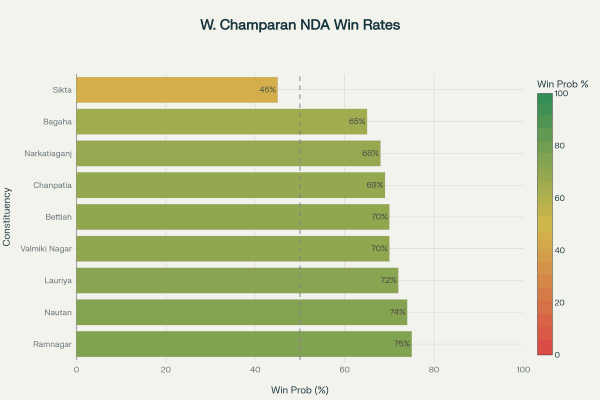
2025 predictions showing NDA likely to win 8/9 seats with Sikta as the competitive battleground
Constituency-wise Probability Analysis
Safe NDA Seats (>70% probability):
- Ramnagar (75%): SC reservation advantage, strong BJP organization
- Nautan (74%): EBC loyalty to NDA, development works
- Lauriya (72%): Tribal vote consolidation, forest department benefits
Likely NDA Wins (65-70% probability):
- Valmiki Nagar (70%): JD(U) incumbency, Tharu support
- Bettiah (70%): Renu Devi’s women appeal, urban development
- Chanpatia (69%): Anti-Congress sentiment, BJP organization
- Narkatiaganj (68%): Border security focus, development narrative
Competitive Seat:
- Bagaha (65%): Flood response criticism, migration issues creating uncertainty
Opposition Opportunity:
- Sikta (45% NDA probability): CPI(ML)L’s traditional stronghold, class polarization
Overall District Projection
Expected Results:
- NDA: 7-8 seats (down 0-1 from 2020)
- Mahagathbandhan: 1-2 seats (up 0-1 from 2020)
- Others: 0-1 seats (stable)
Vote Share Projections:
- NDA: 42-45% (down from 46% in 2020)
- Mahagathbandhan: 35-38% (up from 33% in 2020)
- Others: 15-20% (including Jan Suraaj impact)
Strategic Recommendations
For NDA
Consolidation Strategy:
- Address flood management with concrete infrastructure projects
- Youth employment through expanded startup zones and skill programs
- Tharu community outreach with forest rights and cultural preservation
Campaign Focus:
- Development achievements highlighting infrastructure gains
- Double engine government benefits from central-state coordination
- Stability argument against frequent government changes
For Opposition
Unity Imperative:
- Clear seat sharing to avoid vote division
- Joint campaigning to maximize anti-incumbency sentiment
- Local issue focus rather than national narratives
Issue-based Strategy:
- Employment crisis as primary campaign plank
- Flood management failures highlighting government negligence
- Price rise impact on rural families and farmers
Conclusion
West Champaran district represents a microcosm of Bihar’s evolving political landscape, where traditional vote banks intersect with development aspirations and local governance challenges. While the NDA maintains a strong advantage through organizational strength and development narrative, the opposition has opportunities in addressing employment, flood management, and anti-incumbency sentiment.
The district’s strategic border location, diverse demographic composition, and complex local issues ensure that the 2025 election will test both alliances’ ability to address ground-level concerns while maintaining broader political coalitions.
Key Determinants:
- Youth voter turnout and employment response
- Flood season performance before elections
- Opposition unity versus fragmentation
- Jan Suraaj impact on traditional vote patterns
The election outcome will significantly influence not only Bihar’s political trajectory but also demonstrate the evolving dynamics of development politics, caste consolidation, and local governance effectiveness in contemporary Indian democracy.





